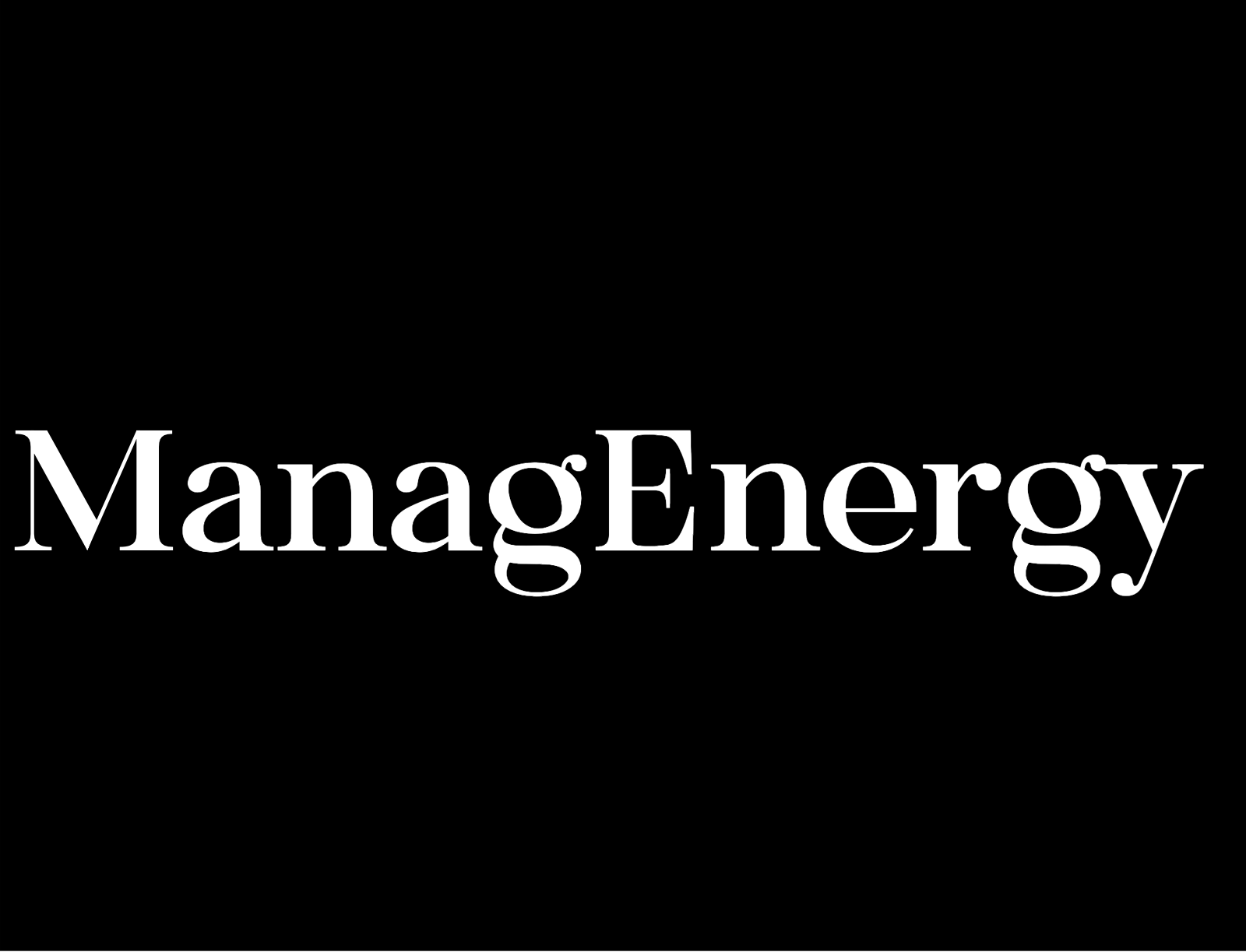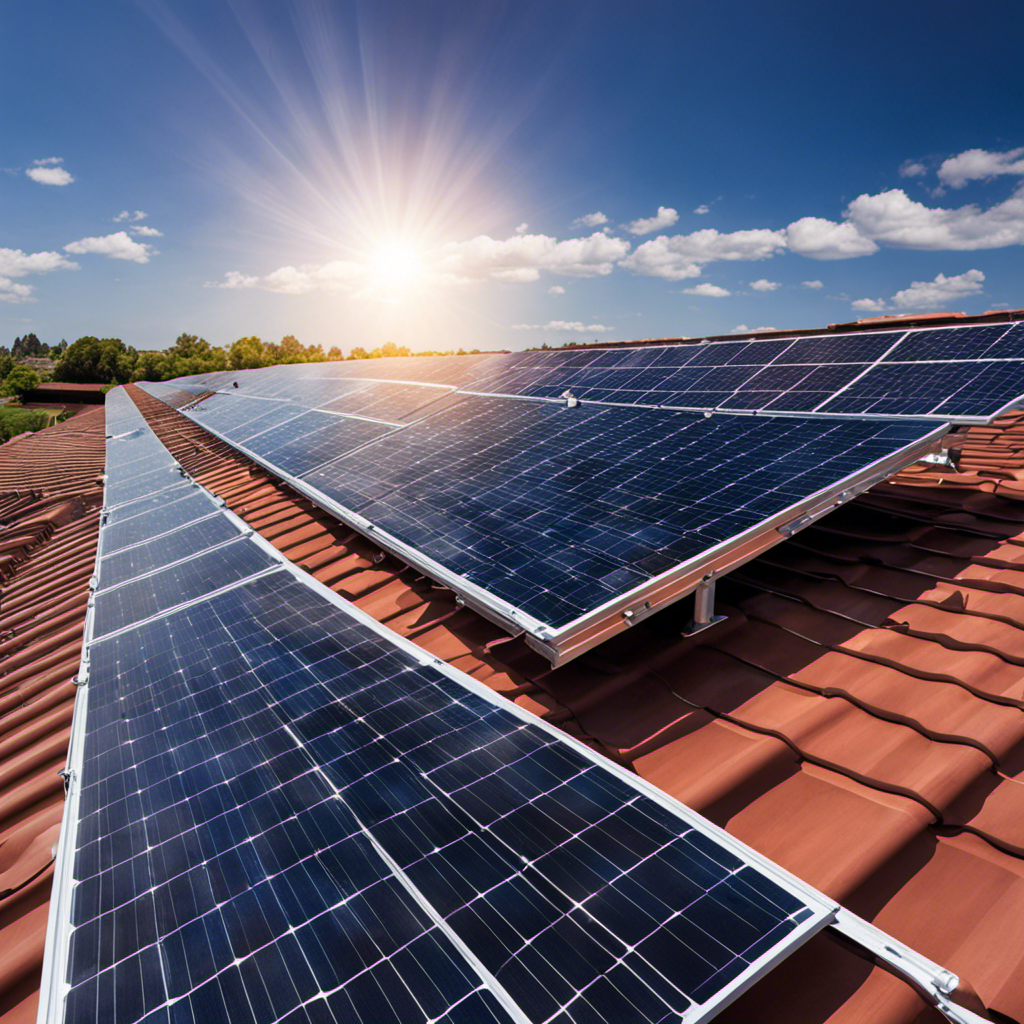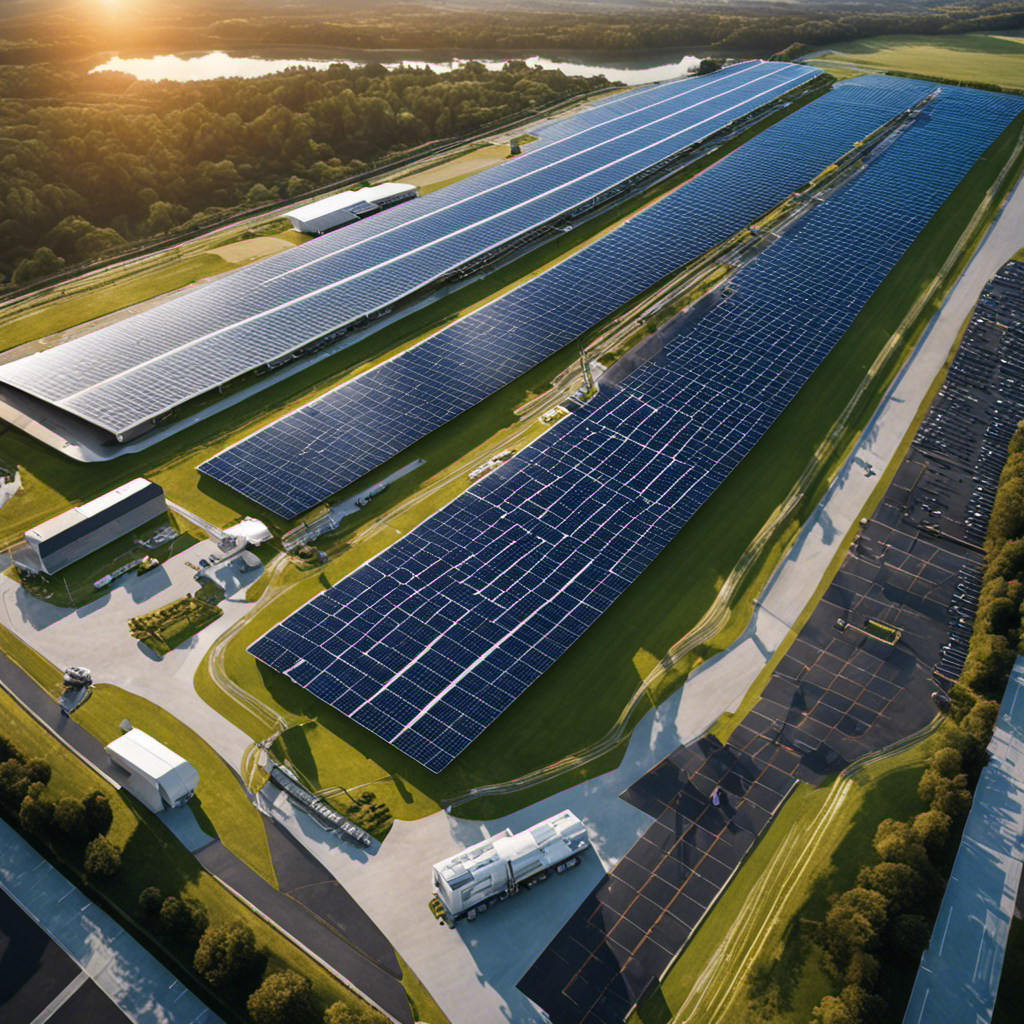Solar
What Percentage Of The World’S Energy Demand Is Met Using Solar Energy
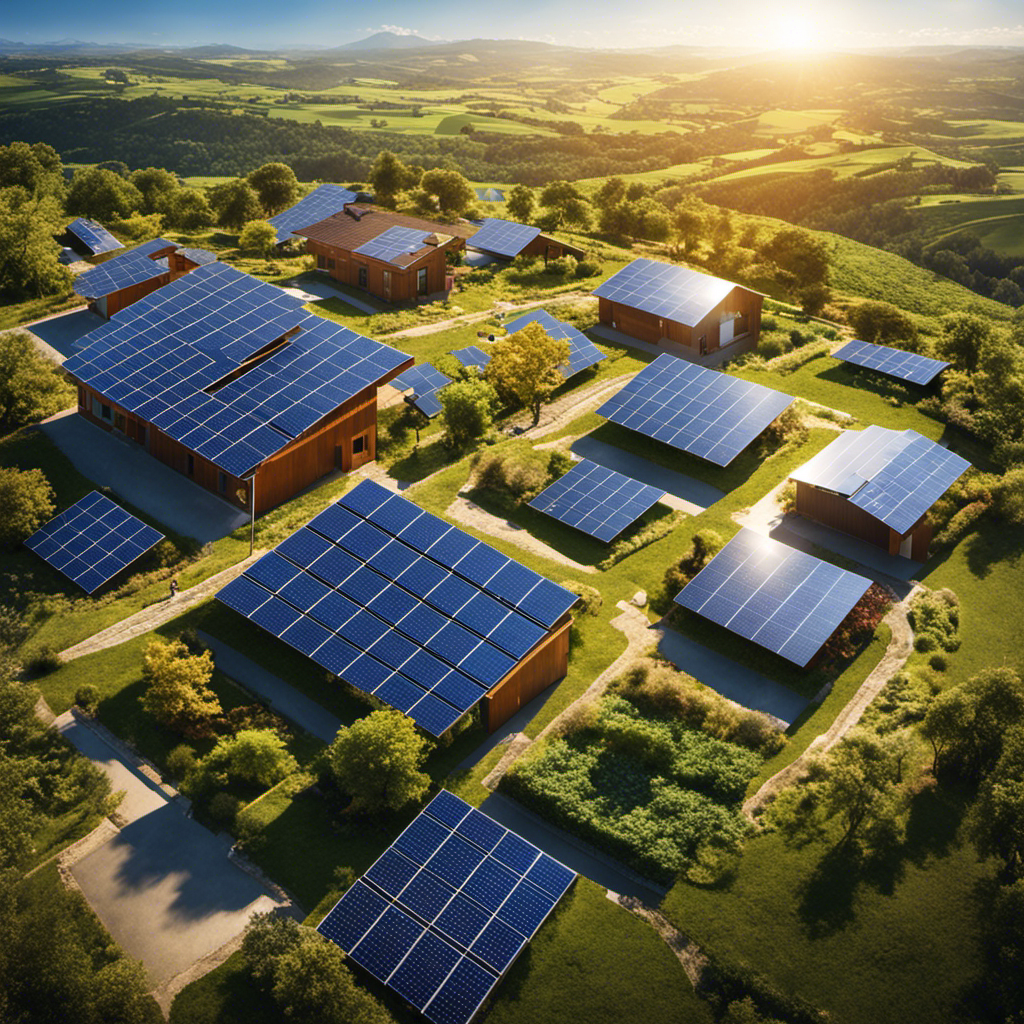
As a curious observer of global energy trends, I find myself pondering a question that holds immense significance: What percentage of the world’s energy demand is met using solar energy?
The suspense surrounding this inquiry stems from the undeniable allure and transformative potential of solar power.
In this article, I will delve into the history, production, and growth of solar energy, exploring the factors that impact its adoption, the challenges it faces, and the advantages it offers in meeting the ever-increasing global energy demand.
Prepare to be enlightened by the data-driven insights that lie ahead.
Key Takeaways
- Solar energy has contributed to the sustainable development goals of developing countries and is seen as a viable alternative due to its affordability and scalability.
- The global solar energy production capacity reached 579.5 GW by the end of 2019, indicating the increasing popularity and adoption of solar power.
- The solar energy market has witnessed significant growth with a compound annual growth rate (CAGR) of over 20% in the past decade, driven by decreasing costs of solar panels, government incentives, and environmental awareness.
- Challenges in meeting energy demand with solar power include cost and affordability, storage and grid integration, and geographic limitations, but addressing these challenges is crucial for widespread adoption of solar energy.
History of Solar Energy Usage
The history of solar energy usage dates back to ancient times when civilizations used sunlight for heating and lighting purposes.
Over the years, there have been significant advancements in solar energy technology, leading to increased efficiency and affordability.
In recent decades, solar energy has gained traction, especially in developing countries. These countries, often lacking access to traditional energy sources, have turned to solar energy as a viable alternative.
The affordability and scalability of solar panels have made it easier for these countries to adopt solar energy solutions.
Additionally, international collaborations and initiatives have further bolstered the use of solar energy in developing countries, providing them with the necessary resources and expertise to implement solar projects.
This has not only helped meet their energy demands but also contributed to their sustainable development goals.
Global Solar Energy Production
You can see how much solar energy is produced globally. Solar energy production capacity has been steadily increasing due to the growing adoption of renewable energy sources.
According to the International Energy Agency (IEA), the global solar energy production capacity reached 579.5 gigawatts (GW) by the end of 2019. This represents a significant increase from previous years, highlighting the rapid growth of solar energy as a viable alternative to traditional forms of energy.
Solar power is becoming increasingly popular due to its environmental benefits and decreasing costs. As the world continues to prioritize sustainability and reduce dependence on fossil fuels, the solar energy market is expected to experience further growth in the coming years.
This transition to renewable energy sources is crucial for a sustainable future and mitigating the impacts of climate change.
Solar Energy Market Growth
Imagine how much the solar energy market has grown due to the increasing demand for renewable sources. It is truly remarkable to witness the trends in the solar energy market.
The adoption of solar technologies has been on a steady rise, with more and more countries and industries recognizing the potential of solar power. According to recent data, the solar energy market has witnessed a compound annual growth rate (CAGR) of over 20% in the past decade. This growth can be attributed to various factors such as decreasing costs of solar panels, government incentives, and the growing awareness of the environmental benefits of solar energy.
Additionally, emerging solar technologies like floating solar farms and solar windows are further driving the market forward. It is evident that the solar energy market is poised for even greater expansion in the coming years.
Factors Affecting Solar Energy Adoption
One of the key factors affecting the adoption of solar technologies is the availability of government incentives. These incentives play a crucial role in encouraging individuals and businesses to invest in solar energy systems. In many countries, governments offer tax credits, grants, and subsidies to offset the high initial costs of installing solar panels. These incentives not only make solar energy more affordable but also help promote grid integration.
Technological advancements in solar energy have made it easier to integrate solar power into existing electricity grids. Smart inverters, advanced monitoring systems, and energy storage solutions have improved the efficiency and reliability of solar energy systems. These advancements have also made it possible to feed excess electricity generated by solar panels back into the grid, further increasing the adoption of solar technologies.
These government incentives and technological advancements have contributed to the growth of solar energy, but there are still challenges in meeting energy demand with solar power.
Challenges in Meeting Energy Demand With Solar Power
Cost and affordability are two key challenges in meeting energy demand with solar power. The initial investment required for installing solar panels can be high, making it less accessible for some individuals and businesses.
Storage and grid integration is another challenge. The integration of storage systems and the grid is crucial for ensuring a continuous and reliable supply of electricity. This is because solar power generation is dependent on weather conditions, so having a way to store excess energy and feed it into the grid when needed is essential.
Geographic limitations also play a role in the feasibility of solar energy generation. Factors such as the availability of sunlight and suitable land can limit the potential for solar power in certain regions. This means that not all areas may be suitable for large-scale solar installations.
Cost and Affordability
Solar energy is becoming increasingly affordable for households and businesses around the world. This cost effectiveness has led to significant investment opportunities in the solar industry. Here are some key points to consider:
-
Decreasing Costs: The cost of solar panels has dropped by more than 70% in the past decade, making it a more accessible option for many consumers.
-
Return on Investment: Installing solar panels can provide a solid return on investment, with payback periods ranging from 5 to 10 years, depending on factors such as location and electricity rates.
-
Government Incentives: Many governments offer incentives, such as tax credits and grants, to encourage the adoption of solar energy systems, further enhancing the financial benefits.
-
Long-Term Savings: Switching to solar energy can lead to significant long-term savings on electricity bills, as solar power is a renewable and free source of energy.
With solar energy becoming more affordable, the focus now shifts towards addressing the challenges of storage and grid integration.
Storage and Grid Integration
As technology advances, finding efficient ways to store and integrate renewable power into existing grids is crucial for the widespread adoption of solar energy.
Grid stability is a key factor that needs to be addressed when integrating renewable energy sources like solar power into the existing electricity grid. The intermittent nature of solar energy creates challenges for grid operators in maintaining a stable supply of electricity.
To ensure grid stability, various strategies are being employed, such as advanced forecasting techniques, energy storage systems, and smart grid technologies. These technologies help balance the fluctuations in solar power generation and demand, ensuring a reliable and stable supply of electricity.
Additionally, renewable energy integration is being facilitated through the development of grid infrastructure and interconnections, enabling the seamless transmission and distribution of solar power across different regions.
Geographic Limitations
Geographic limitations pose challenges for the widespread adoption of renewable power and may require innovative solutions to overcome. While renewable energy sources like solar power have tremendous potential, their implementation is hindered by geographical factors such as limited sunlight availability in certain regions. However, geographical expansion and technological advancements offer promising solutions to overcome these limitations.
-
Solar Panel Efficiency: Improving the efficiency of solar panels can help maximize energy generation in areas with limited sunlight.
-
Offshore Wind Farms: Expanding renewable energy production to offshore locations can tap into stronger and more consistent winds, increasing the overall capacity.
-
Energy Storage Solutions: Advancements in energy storage technologies, such as batteries, can ensure a continuous supply of renewable power even during periods of low sunlight.
-
Grid Interconnectivity: Developing a robust grid infrastructure that connects different regions can enable the transfer of excess renewable energy to areas with higher demand, optimizing resource utilization.
Advantages of Solar Energy for Global Energy Demand
You can benefit from solar energy’s positive impact on global energy demand. Solar energy offers numerous benefits and has a minimal environmental impact.
As the world’s energy demand continues to rise, solar power provides a sustainable and renewable solution. The benefits of solar energy for global energy demand are evident in its ability to reduce greenhouse gas emissions and mitigate climate change. By harnessing the power of the sun, solar energy systems generate electricity without emitting harmful pollutants. This not only improves air quality but also helps combat global warming.
Additionally, solar energy is abundant and inexhaustible, making it a reliable source for meeting the growing energy needs of the world. Embracing solar energy can lead to a more sustainable future for all.
Solar Energy in Different Sectors: Residential, Commercial, and Industrial
Solar energy is widely utilized in various sectors, including residential, commercial, and industrial. It is also being increasingly adopted in transportation and agriculture, offering numerous benefits. Here are some key applications of solar energy in these sectors:
-
Solar energy in transportation: Solar-powered vehicles, such as solar cars and buses, use solar panels to convert sunlight into electricity, reducing the reliance on fossil fuels and minimizing carbon emissions. Additionally, solar energy can be used to power electric vehicle charging stations, making the charging process more sustainable.
-
Solar energy in agriculture: Solar panels can be installed on farms to generate electricity for irrigation systems, greenhouse operations, and other agricultural processes. This reduces the reliance on grid electricity and helps farmers lower their operating costs. Moreover, solar energy can be used to power livestock watering systems and provide electricity for remote agricultural areas.
Government Policies and Incentives for Solar Energy
In examining the impact of government policies and economic incentives for solar energy, it is important to consider the data-driven outcomes.
Government policies play a significant role in shaping the adoption and growth of solar energy. They can provide financial support, tax incentives, and regulatory frameworks that encourage its implementation.
Furthermore, economic incentives such as feed-in tariffs, net metering, and renewable portfolio standards can further drive the economic feasibility and attractiveness of solar energy. These incentives make solar energy more financially viable and appealing for individuals, businesses, and communities.
Overall, the combination of government policies and economic incentives creates a favorable environment for the expansion and utilization of solar energy.
Impact of Government Policies
Government policies have a significant impact on the adoption of solar energy for meeting global energy demand. The following factors highlight the importance of government support in promoting solar energy:
-
Financial incentives: Governments worldwide offer subsidies, tax credits, and grants to encourage the installation of solar panels and reduce the initial costs for consumers.
-
Renewable energy targets: Many countries have set ambitious renewable energy targets, which are crucial in driving the growth of solar energy. These targets create a sense of urgency and encourage investment in solar infrastructure.
-
Net metering policies: Net metering allows solar panel owners to sell excess electricity back to the grid, providing a financial incentive for individuals and businesses to install solar systems.
-
Regulatory frameworks: Governments play a vital role in implementing regulations that facilitate the integration of solar energy into the existing energy grid. These frameworks ensure a smooth transition towards a more sustainable energy future.
Economic Incentives for Solar
You can take advantage of the economic incentives currently available to support the adoption of renewable energy. One of the key incentives for solar energy is the availability of tax credits. These credits can significantly reduce the upfront cost of installing solar panels, making it a more affordable option for homeowners and businesses. Additionally, net metering is another incentive that allows solar energy system owners to sell excess energy back to the grid, offsetting their electricity costs. This arrangement not only helps reduce monthly bills but also contributes to the overall grid stability by utilizing clean energy sources. To further illustrate the benefits of economic incentives, here is a table showcasing the potential savings from tax credits and net metering:
| Incentive | Potential Savings |
|---|---|
| Tax Credits | $5,000 |
| Net Metering | $1,200 |
Future Prospects and Potential of Solar Energy
The future looks bright for solar energy, as its potential to meet a significant portion of the world’s energy demand continues to grow. With future innovations in solar technology, we can expect even greater efficiency and cost-effectiveness. These advancements will further drive the adoption of solar energy on a global scale.
Additionally, the environmental impact of solar energy is a key advantage. Solar power produces zero greenhouse gas emissions during operation, contributing to a reduction in air pollution and combating climate change. Furthermore, solar energy systems have a long lifespan and require minimal maintenance, making them a sustainable and reliable source of power.
As we continue to invest in solar energy, we can look forward to a cleaner and more sustainable future.
Frequently Asked Questions
What Is the Current Cost of Solar Energy Production Compared to Other Forms of Energy?
The current cost of solar energy production is decreasing compared to other forms of energy. This can be attributed to the current market growth and advancements in technology. Additionally, government incentives, such as tax credits and grants, have helped drive down the cost of solar energy.
As a result, solar energy has become more competitive with traditional energy sources. It is important to note that the cost of solar energy production varies depending on factors such as location, installation size, and available resources.
How Does Solar Energy Production Vary Between Different Regions and Countries?
Regional adoption of solar energy varies significantly due to government policies. Some countries have implemented strong incentives and regulations to promote solar energy, leading to high adoption rates. However, other regions may have limited government support, resulting in lower levels of solar energy production.
Factors such as geographical location, climate, and economic conditions also influence the feasibility and attractiveness of solar energy. In order to accurately determine the percentage of world’s energy demand met using solar energy, a comprehensive analysis of regional variations is necessary.
What Are the Environmental Impacts of Solar Energy Production?
When considering the environmental impacts of solar energy production, it is important to evaluate both the benefits and concerns.
Solar energy offers significant environmental benefits, such as reducing greenhouse gas emissions and air pollution.
However, sustainability concerns include the use of toxic materials in solar panel production and the potential impact on land and wildlife habitats.
Are There Any Limitations or Potential Risks Associated With Relying Heavily on Solar Energy?
There are potential risks and limitations associated with relying heavily on solar energy. One challenge is grid integration, as solar power generation fluctuates with weather conditions. This requires careful planning and investment in energy storage systems.
Additionally, solar energy requires large amounts of land and resources for installation, which may limit its scalability.
It is important to consider these factors alongside the benefits of solar energy when assessing its overall feasibility and impact on the global energy landscape.
How Do Solar Energy Technologies and Infrastructure Differ in Residential, Commercial, and Industrial Sectors?
In comparing solar energy technologies and infrastructure across residential, commercial, and industrial sectors, there are notable differences.
In the residential sector, solar energy systems are typically smaller and installed on individual homes.
In the commercial and industrial sectors, utility-scale solar installations are more common.
Additionally, small businesses often have smaller-scale solar systems, while large corporations may have larger, more complex solar infrastructure.
Analyzing the distinctions between residential and utility-scale, as well as small business and large corporation, provides valuable insights into the varied applications of solar energy.
Conclusion
In conclusion, solar energy has emerged as a promising solution to meet the increasing global energy demand. Its history is rooted in ancient civilizations, and in recent years, solar power has experienced rapid growth, becoming a significant contributor to the world’s energy mix.
However, challenges such as high initial costs and the intermittent nature of solar energy continue to hinder its widespread adoption. Despite these obstacles, government policies and incentives are being implemented to promote solar energy, which bodes well for its future prospects.
The sun is often referred to as the ultimate power plant, and it holds immense potential to meet a substantial portion of our energy needs. With ongoing advancements in solar technology and continued support from governments and businesses, the future of solar energy looks bright.
Solar
Who Benefits Most From Solar Energy, Who The Least
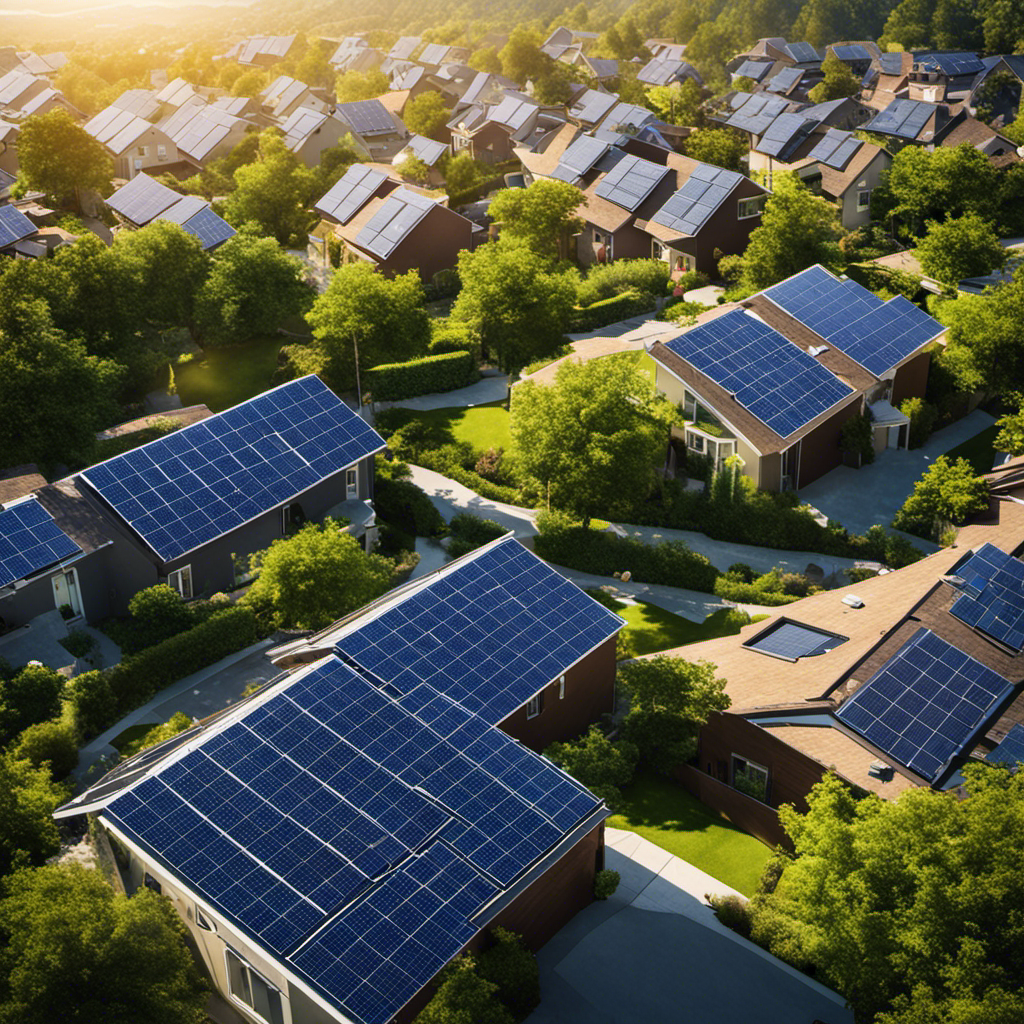
I have always been curious about the individuals or groups that are most and least impacted by solar energy. As solar energy continues to gain popularity, it is crucial to consider the economic inequalities and social consequences associated with its adoption.
In this article, we’ll explore the government policies and support for solar energy, as well as the challenges faced by low-income communities in embracing this renewable source.
Join me as we delve into solutions for ensuring the equitable distribution of solar energy benefits.
Key Takeaways
- Economic disparities and financial constraints hinder access to solar energy for low-income communities and developing countries.
- The adoption of solar energy has positive social and environmental impacts, including reduced greenhouse gas emissions, job creation, and improved quality of life.
- Government policies and incentives have helped make solar energy more affordable and driven investment in renewable energy projects.
- Challenges for low-income communities in embracing solar energy include limited access to capital, lack of knowledge, and limited community engagement. Overcoming these barriers requires community partnerships, education, and financial support.
Economic Disparities and Solar Energy Access
I believe that economic disparities play a significant role in determining who has access to solar energy and who does not.
Economic inequality and energy poverty are closely tied to the availability and affordability of solar energy solutions. According to data, low-income communities and developing countries face greater challenges in accessing solar energy due to financial constraints.
High upfront costs, installation expenses, and maintenance fees make it difficult for economically disadvantaged individuals to adopt solar energy systems. This perpetuates a cycle where those who can afford it benefit from the advantages of solar power, such as reduced electricity bills and environmental benefits, while others are left behind.
Bridging the economic gap and providing financial support to underserved communities is crucial in ensuring equitable access to solar energy and addressing energy poverty.
Social and Environmental Impact of Solar Energy Adoption
As a homeowner, my monthly electricity bills have significantly decreased since adopting solar energy, positively impacting both my wallet and the environment.
The transition to renewable energy hasn’t only empowered my community but also led to various social and environmental benefits.
According to data, solar energy adoption has reduced greenhouse gas emissions, contributing to a cleaner and healthier environment.
It has also created job opportunities, stimulating economic growth and community empowerment.
Additionally, solar energy has provided reliable and affordable electricity to underserved areas, bridging the energy access gap and improving the quality of life for many.
Government Policies and Support for Solar Energy
The government’s commitment to promoting renewable energy through favorable policies and financial incentives has greatly accelerated the adoption of solar power. Government incentives, such as tax credits and grants, have provided financial support to homeowners, businesses, and utilities to invest in solar energy systems. These incentives have helped reduce the upfront costs of installation and made solar power more affordable for many.
In addition, the government has set renewable energy targets to encourage the transition to clean energy sources. These targets have created a sense of urgency and have driven investment in solar energy projects. As a result, the solar industry has experienced significant growth, creating jobs and reducing greenhouse gas emissions.
However, despite these government efforts, there are still challenges for low-income communities in embracing solar energy.
Challenges for Low-Income Communities in Embracing Solar Energy
Low-income communities face financial barriers that hinder their ability to adopt solar power and benefit from the cost savings and environmental advantages it offers. Many factors contribute to these challenges, including limited access to capital, lack of knowledge about solar energy, and the absence of community engagement initiatives.
To illustrate the extent of these challenges, let’s consider the following table:
| Challenges | Impact on Low-Income Communities |
|---|---|
| Limited Access to Capital | Prevents investment in solar infrastructure |
| Lack of Knowledge | Hinders understanding of solar benefits and technology |
| Absence of Community Engagement Initiatives | Limits awareness and support for solar initiatives |
To overcome these barriers, it is crucial to focus on community engagement, education, and awareness. By providing accessible information, training, and financial assistance programs, we can empower low-income communities to embrace solar energy and reap its benefits. Encouraging partnerships between solar companies, government agencies, and community organizations can also play a significant role in overcoming these challenges.
Solutions for Ensuring Equitable Distribution of Solar Energy Benefits
To ensure equitable distribution of solar power advantages, I believe it’s crucial to prioritize accessibility and inclusivity in the implementation of solar energy initiatives.
By forming strong community partnerships, we can ensure that solar energy benefits are accessible to all, regardless of income or social status. These partnerships can help identify and address the specific needs of different communities, ensuring that solar energy initiatives are tailored to their requirements.
Additionally, providing financial incentives can further encourage the adoption of solar energy in low-income communities. These incentives can include grants, tax credits, or subsidies that make solar energy more affordable for those who need it the most.
Frequently Asked Questions
What Are the Potential Health Benefits of Solar Energy Adoption for Low-Income Communities?
Solar energy adoption has the potential to bring significant health benefits to low-income communities. By reducing air pollution and improving overall environmental quality, solar energy can contribute to environmental justice and promote community health.
How Do Government Subsidies and Incentives Impact the Affordability of Solar Energy for Different Income Groups?
Government incentives play a crucial role in making solar energy affordable for different income groups. However, income disparity can limit access to these benefits, creating a need for targeted policies to ensure equal opportunities for all.
How Does the Installation and Maintenance of Solar Panels Affect Property Values in Low-Income Communities?
The installation and maintenance of solar panels in low-income communities can positively impact property values and provide health advantages. This can lead to increased affordability and access to clean energy for those who need it most.
Are There Any Potential Drawbacks or Unintended Consequences of Widespread Solar Energy Adoption in Low-Income Neighborhoods?
There are potential drawbacks and unintended consequences of widespread solar energy adoption in low-income neighborhoods. These include increased costs for residents, potential displacement, and unequal access to benefits.
What Are Some Innovative Financing Options or Community-Led Initiatives That Aim to Increase Access to Solar Energy for Disadvantaged Communities?
Innovative financing options and community-led initiatives are key to increasing access to solar energy for disadvantaged communities. These solutions can help address barriers and ensure that everyone can benefit from the advantages of solar energy.
Conclusion
In conclusion, while solar energy has the potential to benefit all communities, there are still economic disparities that affect access and distribution. According to a recent study, it was found that low-income households make up only a small percentage of solar energy adopters.
This highlights the need for government policies and support to ensure equitable distribution of solar energy benefits. By addressing these challenges, we can work towards a more inclusive and sustainable future powered by solar energy.
Solar
How Many Solar Panels Do I Need On My House To Become Energy Independent

So, you’re interested in achieving energy independence, huh? Get ready because we’re about to explore the realm of solar panels.
In this article, I’ll break down the factors that affect the number of panels you’ll need to power your house. We’ll calculate your energy consumption, evaluate available sunlight, and determine panel efficiency.
By the end, you’ll have a clearer picture of just how many solar panels it takes to break free from the grip of the grid.
Key Takeaways
- The amount of sunlight received and solar panel efficiency are key factors that affect energy generation.
- Analyzing monthly electricity bills and understanding net metering are important for calculating energy consumption and potential savings.
- Evaluating available sunlight, including potential shading factors and optimizing panel placement, is crucial for maximizing solar potential.
- Considering cost implications, maintenance requirements, and energy consumption patterns are essential for determining the ideal number of solar panels needed.
Factors Affecting Solar Panel Requirements
One of the factors that affects the number of solar panels I need for my house to become energy independent is the amount of sunlight my location receives. The more sunlight I receive, the more energy my solar panels can generate. This is an important consideration because it directly impacts the effectiveness and efficiency of the solar panels.
Additionally, cost considerations play a significant role in determining the number of solar panels needed. The upfront cost of installing solar panels can be expensive, so it’s essential to carefully calculate the number of panels required to maximize energy production while keeping costs manageable.
Fortunately, there are government incentives available that can help offset the cost of installing solar panels, such as tax credits and rebates. These incentives can make solar panel installation more affordable and encourage homeowners to invest in renewable energy sources.
Calculating Energy Consumption
To calculate my energy consumption, I’ll need to analyze my monthly electricity bills and determine the average amount of energy I use per month. This is crucial in understanding how many solar panels I’ll need to become energy independent.
By examining my bills over a year, I can get a better estimate of my energy usage patterns and identify any seasonal variations. Once I’ve this information, I can start estimating the costs of installing enough solar panels to cover my energy needs.
It’s important to consider the concept of net metering, which allows me to sell excess energy back to the grid. Understanding net metering will help me determine how many solar panels I’ll need to generate enough energy to offset my consumption and potentially earn credits from my utility company.
Evaluating Available Sunlight
I can evaluate the amount of sunlight that my location receives throughout the year by analyzing historical weather data and using online resources. This information is crucial for evaluating the solar potential of my property and optimizing panel placement.
Here are three key factors to consider when evaluating sunlight availability:
-
Sunlight Duration: Analyzing historical weather data will provide insight into the average number of sunny days and the duration of sunlight in my area. This information helps determine the overall solar potential.
-
Shading: Assessing the potential shading factors in my location is essential. Obstructions such as trees, buildings, or nearby structures can significantly impact the amount of sunlight that reaches my solar panels.
-
Sun Path: Understanding the sun’s path is crucial for optimizing panel placement. By knowing the direction and angle of sunlight throughout the year, I can position my solar panels to capture the maximum amount of energy.
Determining Panel Efficiency
Analyzing the efficiency ratings of different solar panels is crucial in determining which ones will generate the most electricity for my property. Maximizing output and optimizing performance are key factors in achieving energy independence through solar power.
When evaluating solar panels, it’s important to consider their efficiency ratings, which indicate how effectively they convert sunlight into electricity. Higher efficiency ratings mean that the panels can generate more electricity from the same amount of sunlight.
Finding the Ideal Number of Solar Panels
By determining the ideal number of solar panels for my property, I can ensure that I’m maximizing the amount of electricity generated. There are several factors to consider when finding the right number of panels for my needs:
-
Cost considerations: The number of panels will impact the initial cost of the system. More panels mean a higher upfront investment, but they also result in greater energy production and potential savings in the long run.
-
Maintenance requirements: Each panel requires regular cleaning and inspection to ensure optimal performance. Having too many panels can increase the maintenance workload, while having too few may not generate enough energy to meet my needs.
-
Energy consumption: It’s essential to analyze my household’s energy consumption to determine the number of panels required. By understanding my energy usage patterns, I can accurately estimate the number of panels needed to achieve energy independence.
Considering these factors, I can make an informed decision and find the ideal number of solar panels for my property.
Frequently Asked Questions
How Long Do Solar Panels Typically Last Before Needing to Be Replaced?
Solar panels typically last around 25-30 years before needing to be replaced, although some warranties can extend up to 40 years. Factors like weather conditions, maintenance, and quality of materials can affect their lifespan.
Are There Any Government Incentives or Tax Credits Available for Installing Solar Panels?
There are government incentives and tax credits available for installing solar panels. These incentives can help offset the installation costs and shorten the payback period, making solar energy more affordable and attractive.
Can I Sell Excess Energy Generated by My Solar Panels Back to the Power Grid?
Yes, you can sell excess energy generated by your solar panels back to the power grid. It’s a great way to offset your electricity costs and make your solar panel investment even more efficient.
What Kind of Maintenance Is Required for Solar Panels?
Solar panel cleaning and inspection are crucial for maintaining optimal performance. Regular cleaning removes dirt and debris that can hinder efficiency, while inspections ensure any issues are detected and resolved promptly.
How Does the Cost of Installing Solar Panels Compare to the Cost of Traditional Electricity?
Installing solar panels is a cost-effective and environmentally friendly alternative to traditional electricity. It reduces the reliance on fossil fuels and can save on monthly bills. The initial investment is offset by long-term savings.
Conclusion
After carefully evaluating factors such as energy consumption, available sunlight, and panel efficiency, it’s clear that the ideal number of solar panels needed to achieve energy independence varies for each household.
Becoming energy independent is a personal journey, but with the right information and resources, it’s an achievable goal. By harnessing the power of the sun, we can’t only reduce our reliance on traditional energy sources but also contribute to a cleaner and more sustainable future.
Solar
What Is Solar Energy On Earth

While soaking up the sunshine’s warm glow, I couldn’t help but ponder the incredible power it possesses.
Solar energy, a renewable source of power harnessed from the sun, is revolutionizing the way we meet our energy needs. With solar panels converting sunlight into electricity, we can tap into this abundant resource to power our homes, businesses, and even entire communities.
Join me as we delve into the science, benefits, and challenges of harnessing solar energy on Earth.
Key Takeaways
- Solar energy conversion is the process of converting sunlight into usable energy.
- Solar panels absorb solar radiation and convert it into electricity through a photovoltaic effect.
- Solar energy reduces electricity bills and carbon emissions.
- Solar energy is a promising renewable energy source that offers cost-effectiveness, reduced carbon emissions, and minimal water usage.
The Science Behind Solar Energy
I find the science behind solar energy fascinating.
Solar energy conversion is the process of converting sunlight into usable energy.
Solar radiation absorption is a crucial step in this process. When sunlight reaches the Earth’s surface, solar panels absorb the solar radiation and convert it into electricity through a photovoltaic effect.
Solar panels consist of solar cells that are made up of semiconductor materials, such as silicon. When sunlight hits these cells, it excites electrons, creating an electric current.
The efficiency of solar energy conversion depends on various factors, including the type and quality of solar cells, the angle and orientation of the panels, and the amount of sunlight available.
Understanding the science behind solar energy conversion is essential in comprehending how solar panels work to harness the power of the sun.
How Solar Panels Work
As someone who’s interested in renewable energy, I find it fascinating how solar panels harness the power of the sun and convert it into electricity. The installation process for solar panels involves mounting them on rooftops or in open areas where they can receive maximum sunlight.
Once installed, solar panels require minimal maintenance. Regular cleaning to remove dust and debris is necessary to ensure optimal performance. It’s also important to inspect and tighten any loose connections to prevent any potential issues.
Solar panels have a long lifespan, typically around 25 to 30 years, and they come with warranties to cover any defects or malfunctions.
In the next section, we’ll explore the different types of solar energy systems available and their respective advantages and disadvantages.
Types of Solar Energy Systems
One of the most common types of solar energy systems is the photovoltaic (PV) system, which uses solar cells to directly convert sunlight into electricity. PV systems are widely used for both residential and commercial applications. These systems generate electricity during the day when sunlight is available and can store excess energy for later use.
Solar energy storage is an important aspect of PV systems as it allows for a continuous supply of electricity even when the sun isn’t shining. The stored energy can be used at night or during cloudy days, making solar energy a reliable source of power.
In addition to residential and commercial applications, solar energy is also used in various sectors such as agriculture, transportation, and telecommunications, contributing to a more sustainable and environmentally friendly future.
Advantages of Solar Energy
Using the sun’s rays to generate electricity has numerous benefits, such as reducing electricity bills and decreasing carbon emissions. Solar energy is cost-effective, as it harnesses the natural power of the sun, which is abundant and free. Once the initial installation cost is covered, the operational costs are significantly lower compared to traditional energy sources.
Additionally, solar energy has a positive environmental impact. It doesn’t produce greenhouse gas emissions or air pollutants, thus contributing to cleaner air and mitigating climate change. Moreover, solar energy systems require minimal water usage, reducing strain on water resources. These factors make solar energy an attractive option for both individuals and businesses looking to save money and reduce their carbon footprint.
However, there are some challenges and limitations associated with solar energy.
Challenges and Limitations of Solar Energy
I’ve encountered challenges when it comes to harnessing the sun’s power for electricity generation. While solar energy has many advantages, there are limitations that need to be addressed. Here are some key challenges:
-
Cost effectiveness: Despite the decreasing cost of solar panels, the initial installation cost is still high. This can make it difficult for some individuals or businesses to invest in solar energy systems.
-
Storage solutions: Solar energy is intermittent, as it depends on sunlight availability. This poses a challenge for storing excess energy during peak production periods for later use. Developing efficient and cost-effective storage solutions is crucial for maximizing the benefits of solar energy.
-
Efficiency: Solar panels currently have an average efficiency of around 20%. Improving the efficiency of solar cells is vital to increase the amount of electricity generated from sunlight.
-
Land requirement: Large-scale solar installations require significant land space, which can be a challenge in densely populated areas.
-
Environmental impact: The production and disposal of solar panels can have environmental consequences. Finding sustainable and environmentally-friendly manufacturing processes is essential.
Addressing these challenges will contribute to a more widespread adoption of solar energy and its potential as a renewable and clean power source.
Frequently Asked Questions
How Does Solar Energy Affect the Environment?
Solar energy reduces carbon emissions and has a positive impact on wildlife. It is a renewable and clean source of power, harnessing the sun’s energy to generate electricity without harmful emissions, benefiting the environment and preserving biodiversity.
What Are the Long-Term Economic Benefits of Using Solar Energy?
Using solar energy has a positive impact on economic growth and job creation. When I installed solar panels on my house, it not only reduced my energy bills but also contributed to local job opportunities in the solar industry.
Can Solar Energy Be Used in All Types of Climates?
Yes, solar energy can be used in all types of climates. However, extreme weather conditions and variations in sunlight intensity can impact the generation of solar energy.
Are There Any Health Risks Associated With Solar Energy?
There are potential health risks from prolonged solar exposure. It is important to protect oneself from harmful UV radiation by wearing sunscreen, protective clothing, and sunglasses. Regularly checking for skin abnormalities is also recommended.
Can Solar Energy Be Used to Power Large-Scale Industries or Only for Residential Purposes?
Solar energy can be used for commercial purposes, not just residential. It has the potential to power large-scale industries efficiently. The efficiency of solar energy systems varies depending on factors like location, weather conditions, and technology used.
Conclusion
After exploring the science and mechanics of solar energy, it’s clear that this renewable source has immense potential to power our planet. Its advantages, such as reducing greenhouse gas emissions and lowering electricity costs, are supported by data and scientific evidence.
However, while solar energy is a promising solution, it also faces challenges and limitations that need to be addressed. Continued research and development will be crucial in harnessing the full potential of solar energy and ensuring a sustainable future.
-

 Sustainable Supply Chain Management5 months ago
Sustainable Supply Chain Management5 months agoManagEnergy Acquires GPST2030.org Domain to Strengthen Commitment to Sustainable Transport
-

 Wind Energy5 months ago
Wind Energy5 months agoHow Much Oil Does It Take To Lubricate A Wind Turbine
-

 Electric Motorbike3 months ago
Electric Motorbike3 months agoCalifornia Electric Motorcycle Laws: A Comprehensive Guide to Riding Safely
-

 Solar4 months ago
Solar4 months agoIn 2009, About What Percent Of U.S. Energy Consumption Was Supplied By Solar Energy
-

 Electricity Vehicle3 months ago
Electricity Vehicle3 months agoThe Future of Electric Vehicles: Trends and Innovations to Watch
-

 Wind Energy3 months ago
Wind Energy3 months agoRevolutionizing Highways: Wind Turbines Take the Road to Renewable Energy
-
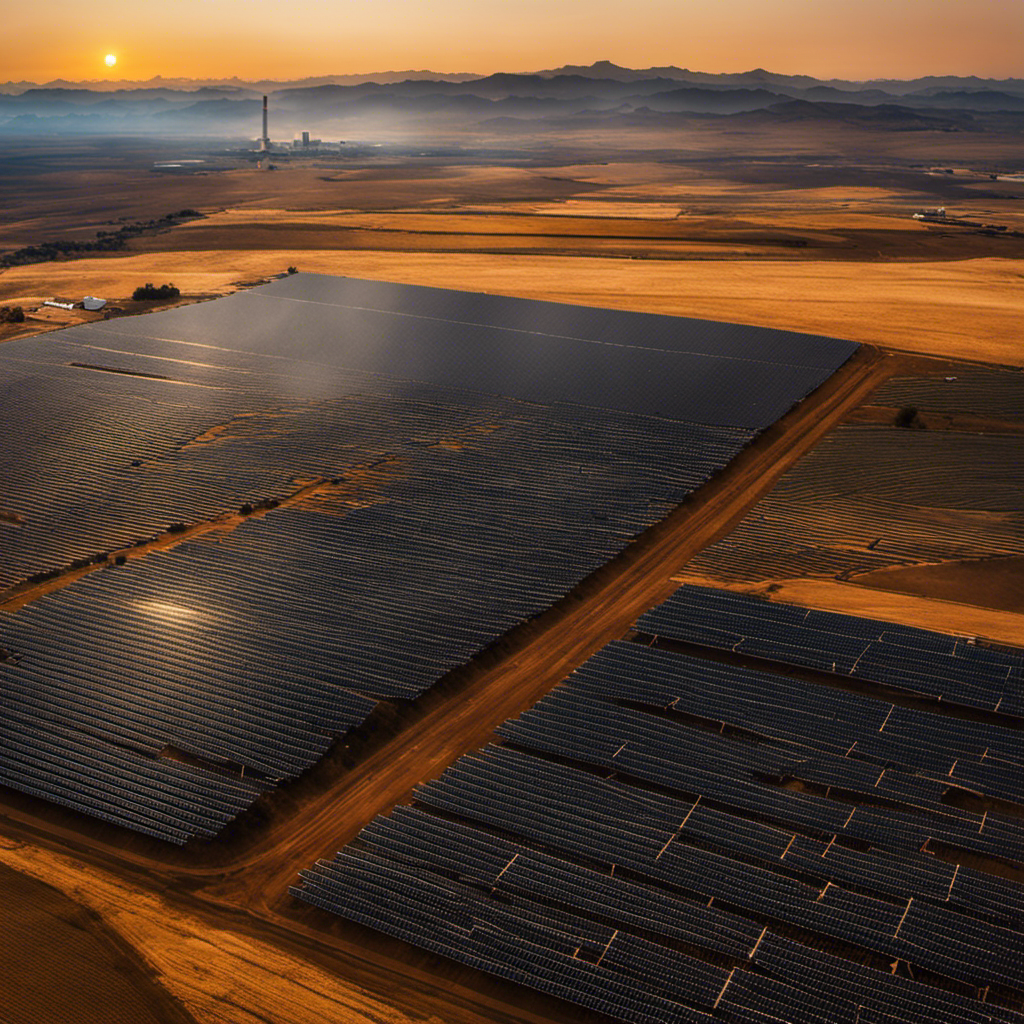
 Solar4 months ago
Solar4 months agoWhy Should We Use Solar Energy Instead Of Fossil Fuels
-

 Wind Energy4 months ago
Wind Energy4 months agoWhat Is The Minimum And Maximum Wind Speed For Operating A Wind Turbine
